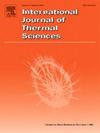IF 4.9
2区 工程技术
Q1 ENGINEERING, MECHANICAL
International Journal of Thermal Sciences
Pub Date : 2025-03-17
DOI:10.1016/j.ijthermalsci.2025.109866
引用次数: 0
摘要
在反应堆安全分析中,熔池的分层现象对于设计舱内保留技术至关重要。在利用电磁冷坩埚进行熔池分层实验研究的过程中,电磁场会影响熔池结构形态的演变。本研究构建了一个耦合电磁场、流场、温度场和两相流动的多物理场模型,以研究电磁场中不相溶两相液体的形态结构、传热和流体动力学。模型重点研究了洛伦兹力、浮力、表面张力、温度梯度和凝固对两相液体结构的影响。液相结构的模拟结果与实验结果非常吻合。计算结果表明,当受到电磁场作用时,由于趋肤效应,金属表面会受到很大的洛伦兹力。因此,金属被推向熔池中心。浮力使金属停留在熔池上方。在洛伦兹力和表面张力的共同作用下,金属呈半球形。在没有洛伦兹力的情况下,浮力比两液相之间的相互作用力更大,导致金属在熔池中扩散。此外,温度梯度导致的自然对流也会影响熔池流动。在熔池凝固过程中,侧壁上氧化物的凝固限制了金属的流动和形态。研究发现,熔池主要受洛伦兹力影响,其次是浮力和自然对流,而表面张力对熔池形态的影响最小。这些发现有助于理解电磁场中具有不同导电率的不溶液相的复杂形态演变过程。本文章由计算机程序翻译,如有差异,请以英文原文为准。
Numerical study on the liquid phase structural evolution of high-temperature metal-oxide mixture in the magnetic field
In reactor safety analysis, the stratification phenomenon of the molten pool is crucial for the design of in-vessel retention techniques. During the course of the experimental study on the stratification of the molten pool using an electromagnetic cold crucible, the electromagnetic field affects the evolution of the structural morphology of the molten pool. This study constructs a multi-physics field model coupling electromagnetic field, flow field, temperature field, and two-phase flow to investigate the morphological structure, heat transfer, and fluid dynamics of immiscible two-phase liquids in the electromagnetic field. The model focuses on the effects of Lorentz force, buoyancy, surface tension, temperature gradients, and solidification on the two-phase liquid structure. The simulated result of the liquid-phases’ structure aligns well with experimental results. The computational results show that when subjected to an electromagnetic field, the metal surface undergoes a significant Lorentz force owing to the skin effect. Therefore, the metal was pushed towards the center of the molten pool. The buoyancy force causes the metal to reside above the molten pool. And under the combined effects of the Lorentz force and surface tension, the metal adopts a semi-spherical shape. In the absence of the Lorentz force, the buoyancy force predominates over the interaction forces between the two liquid phases, causing the metal to spread over the molten pool. In addition, natural convection due to temperature gradients affects the molten pool flow. During the solidification of the molten pool, the solidification of the oxide on the sidewalls restricts the flow and morphology of the metal. The study finds that the molten pool is primarily influenced by Lorentz force, followed by buoyancy force and natural convection, while surface tension has the least impact on the molten pool's morphology. These findings contribute to the understanding of the complex morphological evolution process of immiscible liquid phases with different conductivities in an electromagnetic field.
求助全文
通过发布文献求助,成功后即可免费获取论文全文。
去求助
来源期刊

International Journal of Thermal Sciences
工程技术-工程:机械
CiteScore
8.10
自引率
11.10%
发文量
531
审稿时长
55 days
期刊介绍:
The International Journal of Thermal Sciences is a journal devoted to the publication of fundamental studies on the physics of transfer processes in general, with an emphasis on thermal aspects and also applied research on various processes, energy systems and the environment. Articles are published in English and French, and are subject to peer review.
The fundamental subjects considered within the scope of the journal are:
* Heat and relevant mass transfer at all scales (nano, micro and macro) and in all types of material (heterogeneous, composites, biological,...) and fluid flow
* Forced, natural or mixed convection in reactive or non-reactive media
* Single or multi–phase fluid flow with or without phase change
* Near–and far–field radiative heat transfer
* Combined modes of heat transfer in complex systems (for example, plasmas, biological, geological,...)
* Multiscale modelling
The applied research topics include:
* Heat exchangers, heat pipes, cooling processes
* Transport phenomena taking place in industrial processes (chemical, food and agricultural, metallurgical, space and aeronautical, automobile industries)
* Nano–and micro–technology for energy, space, biosystems and devices
* Heat transport analysis in advanced systems
* Impact of energy–related processes on environment, and emerging energy systems
The study of thermophysical properties of materials and fluids, thermal measurement techniques, inverse methods, and the developments of experimental methods are within the scope of the International Journal of Thermal Sciences which also covers the modelling, and numerical methods applied to thermal transfer.
 求助内容:
求助内容: 应助结果提醒方式:
应助结果提醒方式:


